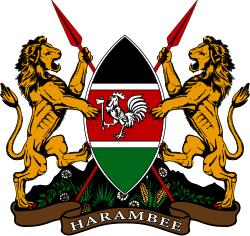| Coat of arms of Kenya | |
|---|---|
 | |
| Armiger | Republic of Kenya |
| Adopted | 1963 |
| Shield | Per fess sable and vert, on a fess gules fimbriated argent a cock grasping in the dexter claw an axe also argent. |
| Supporters | On either side a lion or, grasping in the interior forepaw a spear of estate, the hafts of the spears crossed in saltire behind the shield. |
| Compartment | The whole upon a compartment representing Mount Kenya proper. |
| Motto | Harambee (Let's pull together in Swahili) |
The coat of arms of Kenya features two lions, a symbol of protection, holding spears and a traditional East African shield. The shield and spears symbolize unity and defence of freedom. The shield contains the national colours, representing: [1]
Contents
- Black for the people of Kenya.
- Red for the blood shed during the struggle for freedom.
- Green for the agriculture and natural resources.
- White for unity and peace.
On the shield is a rooster holding an axe while moving forward, portraying authority, the will to work, success, and the break of a new dawn. It is also the symbol of Kenya African National Union (KANU) party that led the country to independence.
The shield and lions stand on a silhouette of Mount Kenya containing in the foreground examples of Kenya agricultural produce - coffee, pyrethrum, sisal, tea, maize and pineapples.
The coat of arms is supported by a scroll upon which is written the word 'Harambee'. In Swahili, Harambee means "pulling together" or "all for one".



